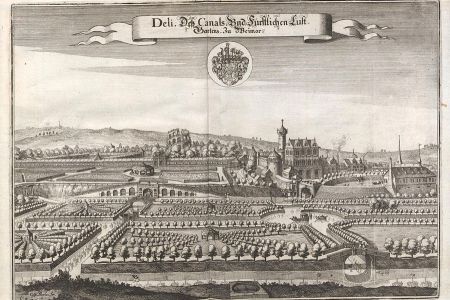Goethe influenced the design of the park on the Ilm
- Written by Portal Editor
Again and again, our visits to the city of Weimar also lead to the large park that stretches along the Ilm almost right through the city.
Some time ago we visited the garden house of Johann Wolfgang von Goethe, we also visited the Roman house and again and again you come across the name of Goethe, who at least helped shape numerous objects here in the city. Time to deal with the background of the park landscape itself.
Rock stairs and bark houses are the oldest elements
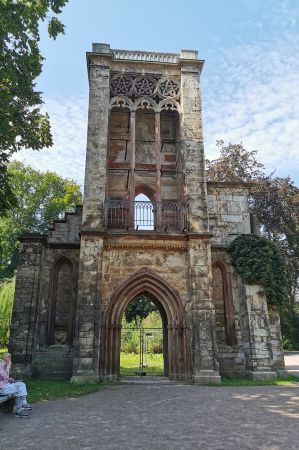 The redesign of the park away from the Lustgarten began in 1776 under the significant influence of Johann Wolfgang Goethe in the style of a sentimental English landscape garden. The former pleasure garden, which was previously based on the design language of the baroque, was radically redesigned. The oldest surviving parts of the park are the so-called rock stairs as the eye of the needle near the raft bridge, which Goethe had created in memory of the suicide of Christiane Henriette Sophie von Laßberg, often called Christel von Laßberg by Goethe. It is said to have been the Livonian Baron von Wrangel, with whom she fell unhappily in love. Apart from the rock staircase, the bark house, which was a place of retreat for Karl August, is the oldest preserved part of the Ilmpark. The bark house is the only remaining part of the so-called Luisenkloster, where the old powder tower used to stand, which was included in the Luisenkloster. In a way, it served as a backdrop for the theatre.
The redesign of the park away from the Lustgarten began in 1776 under the significant influence of Johann Wolfgang Goethe in the style of a sentimental English landscape garden. The former pleasure garden, which was previously based on the design language of the baroque, was radically redesigned. The oldest surviving parts of the park are the so-called rock stairs as the eye of the needle near the raft bridge, which Goethe had created in memory of the suicide of Christiane Henriette Sophie von Laßberg, often called Christel von Laßberg by Goethe. It is said to have been the Livonian Baron von Wrangel, with whom she fell unhappily in love. Apart from the rock staircase, the bark house, which was a place of retreat for Karl August, is the oldest preserved part of the Ilmpark. The bark house is the only remaining part of the so-called Luisenkloster, where the old powder tower used to stand, which was included in the Luisenkloster. In a way, it served as a backdrop for the theatre.
Goethe acquires a garden house – formerly a winegrower's house
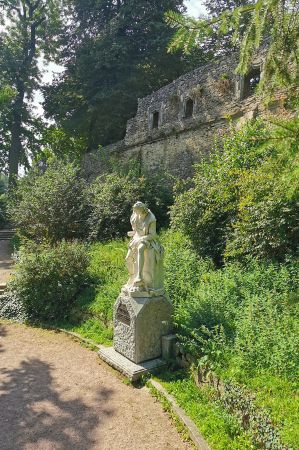 In its vicinity, the artificial ruins were built in 1784, in which the old shooting wall was included or redesigned. It was named after Duchess Luise, on whose name day, July 9, 1778, it was created.
In its vicinity, the artificial ruins were built in 1784, in which the old shooting wall was included or redesigned. It was named after Duchess Luise, on whose name day, July 9, 1778, it was created.
In the spring of 1776, Goethe also acquired the garden house on the east slope of the park, which is now named after him and which may have been a vintner's house in the past, especially since wine was grown there until the mid-17th century. But that was no longer the case in Goethe's time.
After that, the slope became a kind of orchard, where vegetables were also grown.
A 1777 depiction by Georg Melchior Kraus, of whom there are several depictions of parts of the Ilm Park, shows this.
Georg Melchior Kraus and Johann Wolfgang von Goethe
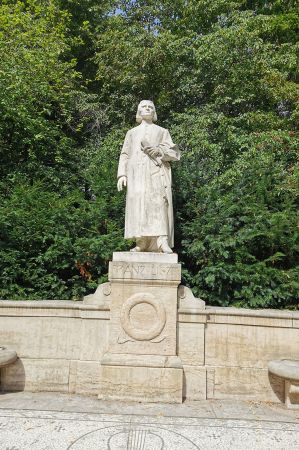 From 1759 to 1762 the court painter Johann Heinrich Tischbein the Elder trained the young Georg Melchior Kraus in his studio as a painter at the court of Landgrave Friedrich II in Kassel.
From 1759 to 1762 the court painter Johann Heinrich Tischbein the Elder trained the young Georg Melchior Kraus in his studio as a painter at the court of Landgrave Friedrich II in Kassel.
In November 1762, Kraus travelled to Paris to study with one of the most important engravers of the time, Johann Georg Wille, where he also met the genre painter Jean-Baptiste Greuze.
In Paris he held the title "peintre de genre familier de S.A.S. le prince Evêque de Wirsbourg".
At the end of 1766 Kraus returned to Frankfurt and initially worked as a private drawing teacher and genre painter. In Frankfurt he gave drawing lessons to Sophie von La Roche, Friedrich Heinrich Jacobi and others, as well as to Johann Wolfgang von Goethe.
"Princely free drawing school" in Weimar
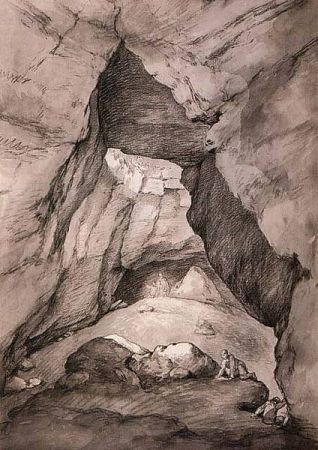 There, in 1773, Kraus made contact with personalities such as Christoph Martin Wieland and Friedrich Justin Bertuch, who introduced him to the Weimar court.
There, in 1773, Kraus made contact with personalities such as Christoph Martin Wieland and Friedrich Justin Bertuch, who introduced him to the Weimar court.
After several brief visits, Kraus moved permanently to Weimar in the fall of 1775.
Apart from short trips, he spent the entire second half of his life there.
He befriended Bertuch, who at the time was secret secretary and steward of the young Duke Carl August of Saxe-Weimar.
Together, Kraus and Bertuch submitted a memorandum in Weimar in 1774 entitled “Draft for a free drawing school to be set up here with few resources”.
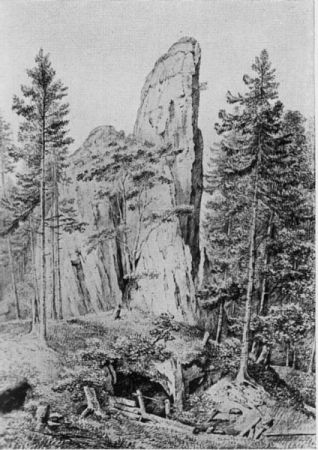 In 1775, during a visit to his hometown of Frankfurt, he taught Goethe about conditions in Weimar, even before he received an invitation from Duke Carl August, who founded and financed the "Princely Free Drawing School" in Weimar as one of his first official acts in 1776.
In 1775, during a visit to his hometown of Frankfurt, he taught Goethe about conditions in Weimar, even before he received an invitation from Duke Carl August, who founded and financed the "Princely Free Drawing School" in Weimar as one of his first official acts in 1776.
Georg Melchior Kraus was appointed the first director and held this position until his death.
In addition to him, u. a. the sculptor Martin Gottlieb Klauer and the painters Konrad Horny and Johann Ernst Heinsius. In 1784, Kraus accompanied Johann Wolfgang von Goethe on his third journey through the Harz Mountains (August 8 to September 14, 1784) in order to record geological studies in drawings, including a drawing of the so-called Unicorn Cave and one of the Hübichenstein.
Stone of good luck in the park on the Ilm
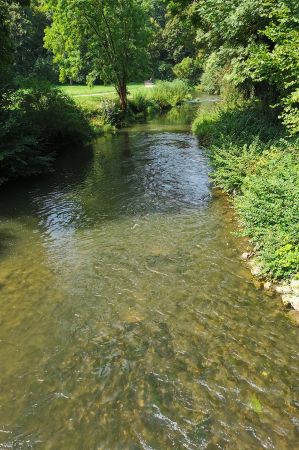 In the garden is the so-called and well-known stone of good luck. The design of the park draws on the experience gained when laying out the Wörlitzer Park, which can be traced back to the close relationship between the Weimar Grand Duke Karl August and Prince Franz von Anhalt-Dessau.
In the garden is the so-called and well-known stone of good luck. The design of the park draws on the experience gained when laying out the Wörlitzer Park, which can be traced back to the close relationship between the Weimar Grand Duke Karl August and Prince Franz von Anhalt-Dessau.
In 1782, as a memorial and as a symbol of his friendship with the Prince of Dessau, Karl August had the Dessau Stone erected in the park on the west bank of the Ilm from a five-meter-high travertine slab, which bears the inscription "Francisco Dessaviae Principi" on a sandstone plaque laid in 1787.
This large stone was erected in November 1782 at a bend in the path in the cold kitchen. This in turn is Adam Friedrich Oeser's last work for Weimar in cooperation with Goethe.
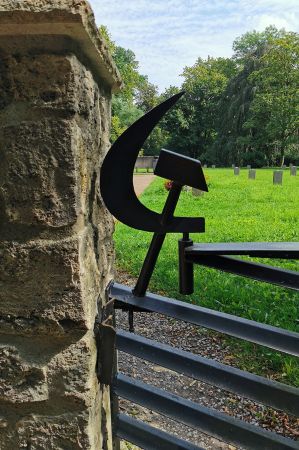 In general, the Weimar Park landscape can hardly be imagined without the not entirely problem-free cooperation between Goethe and Oeser. However, Oeser also made several designs for Tiefurt for Duchess Anna Amalia afterwards.
In general, the Weimar Park landscape can hardly be imagined without the not entirely problem-free cooperation between Goethe and Oeser. However, Oeser also made several designs for Tiefurt for Duchess Anna Amalia afterwards.
Not only was the park architecture destroyed or damaged as a result of the Second World War, but the planting was also badly damaged. Reconstruction and replanting took place under the direction of Hermann Schüttauf in the 1950s.
Please read as well:
Visit of Goethe's garden house in Weimar
Outdoor - Beautiful parks and garden city in Norwich
-
 Hiking through Parkt at Ilm river Weimar
Hiking through Parkt at Ilm river Weimar
Hiking through Parkt at Ilm river Weimar
Hiking through Parkt at Ilm river Weimar
-
 Hiking through Parkt at Ilm river Weimar
Hiking through Parkt at Ilm river Weimar
Hiking through Parkt at Ilm river Weimar
Hiking through Parkt at Ilm river Weimar
-
 Hiking through Parkt at Ilm river Weimar
Hiking through Parkt at Ilm river Weimar
Hiking through Parkt at Ilm river Weimar
Hiking through Parkt at Ilm river Weimar
-
 Hiking through Parkt at Ilm river Weimar
Hiking through Parkt at Ilm river Weimar
Hiking through Parkt at Ilm river Weimar
Hiking through Parkt at Ilm river Weimar
-
 Hiking through Parkt at Ilm river Weimar
Hiking through Parkt at Ilm river Weimar
Hiking through Parkt at Ilm river Weimar
Hiking through Parkt at Ilm river Weimar
-
 Hiking through Parkt at Ilm river Weimar
Hiking through Parkt at Ilm river Weimar
Hiking through Parkt at Ilm river Weimar
Hiking through Parkt at Ilm river Weimar
-
 Hiking through Parkt at Ilm river Weimar
Hiking through Parkt at Ilm river Weimar
Hiking through Parkt at Ilm river Weimar
Hiking through Parkt at Ilm river Weimar
-
 Hiking through Parkt at Ilm river Weimar
Hiking through Parkt at Ilm river Weimar
Hiking through Parkt at Ilm river Weimar
Hiking through Parkt at Ilm river Weimar
-
 Hiking through Parkt at Ilm river Weimar
Hiking through Parkt at Ilm river Weimar
Hiking through Parkt at Ilm river Weimar
Hiking through Parkt at Ilm river Weimar
-
 Hiking through Parkt at Ilm river Weimar
Hiking through Parkt at Ilm river Weimar
Hiking through Parkt at Ilm river Weimar
Hiking through Parkt at Ilm river Weimar
-
 Hiking through Parkt at Ilm river Weimar
Hiking through Parkt at Ilm river Weimar
Hiking through Parkt at Ilm river Weimar
Hiking through Parkt at Ilm river Weimar
-
 Hiking through Parkt at Ilm river Weimar
Hiking through Parkt at Ilm river Weimar
Hiking through Parkt at Ilm river Weimar
Hiking through Parkt at Ilm river Weimar
-
 Hiking through Parkt at Ilm river Weimar
Hiking through Parkt at Ilm river Weimar
Hiking through Parkt at Ilm river Weimar
Hiking through Parkt at Ilm river Weimar
-
 Hiking through Parkt at Ilm river Weimar
Hiking through Parkt at Ilm river Weimar
Hiking through Parkt at Ilm river Weimar
Hiking through Parkt at Ilm river Weimar
-
 Hiking through Parkt at Ilm river Weimar
Hiking through Parkt at Ilm river Weimar
Hiking through Parkt at Ilm river Weimar
Hiking through Parkt at Ilm river Weimar
https://www.alaturka.info/en/germany/thuringia/6260-goethe-influenced-the-design-of-the-park-on-the-ilm#sigProId663b4540c3
